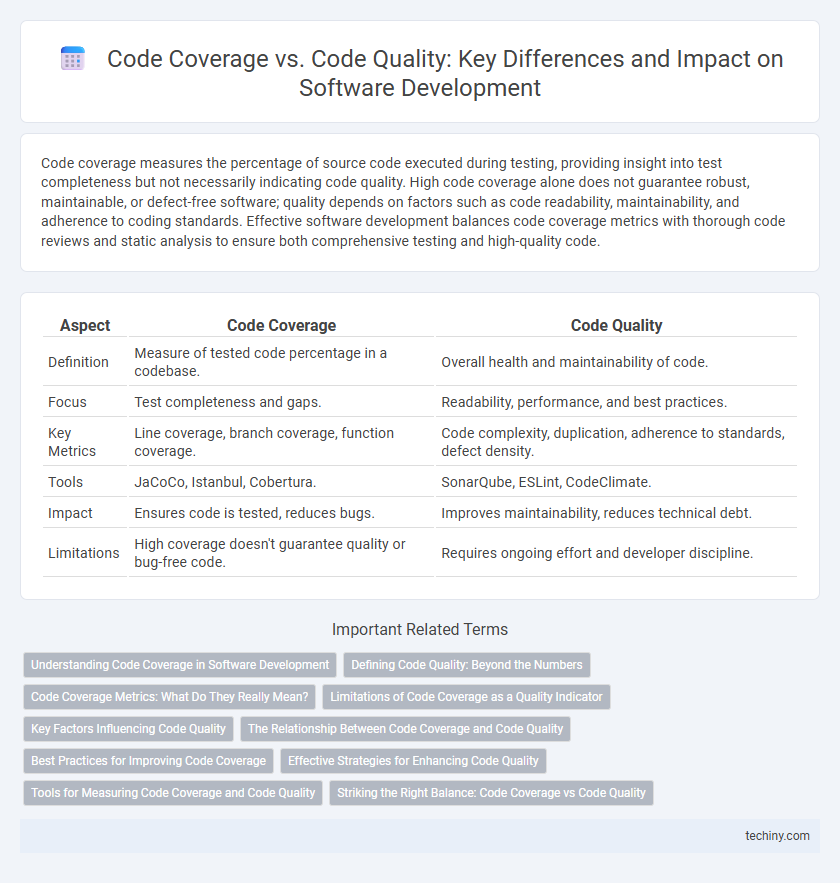Code coverage measures the percentage of source code executed during testing, providing insight into test completeness but not necessarily indicating code quality. High code coverage alone does not guarantee robust, maintainable, or defect-free software; quality depends on factors such as code readability, maintainability, and adherence to coding standards. Effective software development balances code coverage metrics with thorough code reviews and static analysis to ensure both comprehensive testing and high-quality code.
Table of Comparison
| Aspect | Code Coverage | Code Quality |
|---|---|---|
| Definition | Measure of tested code percentage in a codebase. | Overall health and maintainability of code. |
| Focus | Test completeness and gaps. | Readability, performance, and best practices. |
| Key Metrics | Line coverage, branch coverage, function coverage. | Code complexity, duplication, adherence to standards, defect density. |
| Tools | JaCoCo, Istanbul, Cobertura. | SonarQube, ESLint, CodeClimate. |
| Impact | Ensures code is tested, reduces bugs. | Improves maintainability, reduces technical debt. |
| Limitations | High coverage doesn't guarantee quality or bug-free code. | Requires ongoing effort and developer discipline. |
Understanding Code Coverage in Software Development
Code coverage measures the percentage of code executed during testing, providing insight into test completeness but not directly indicating code quality. High code coverage ensures most code paths are tested, reducing undetected bugs and improving reliability. However, true code quality depends on code readability, maintainability, and proper design beyond just coverage metrics.
Defining Code Quality: Beyond the Numbers
Code quality encompasses more than just code coverage percentages, as it involves maintainability, readability, and adherence to coding standards that ensure long-term project sustainability. High code coverage indicates extensive testing but does not guarantee reliable or efficient software if the underlying code is poorly structured or difficult to understand. Evaluating code quality requires analyzing factors such as code complexity, documentation, and defect rates alongside coverage metrics to achieve comprehensive software excellence.
Code Coverage Metrics: What Do They Really Mean?
Code coverage metrics quantify the percentage of source code executed during testing, highlighting untested areas but not directly measuring code quality or correctness. High code coverage indicates thorough testing scope but does not guarantee fewer bugs or better maintainability without considering test effectiveness and code complexity. Understanding code coverage's role helps software teams balance testing efforts and improve overall software reliability and quality.
Limitations of Code Coverage as a Quality Indicator
Code coverage measures the percentage of code executed during tests but does not account for the correctness or efficiency of the code, limiting its reliability as a sole quality indicator. High code coverage can still accompany poorly written or buggy code if tests lack depth in validating logic and edge cases. True code quality assessment requires combining coverage metrics with static analysis, code reviews, and performance profiling to capture maintainability and functional integrity.
Key Factors Influencing Code Quality
Code quality is primarily influenced by factors such as code readability, maintainability, and adherence to coding standards, which ensure efficient collaboration and ease of future updates. While code coverage measures the extent to which automated tests execute the codebase, it does not necessarily reflect the effectiveness or robustness of the tests themselves. High code quality requires comprehensive testing strategies combined with consistent code reviews, refactoring, and static analysis to identify potential bugs and optimize performance.
The Relationship Between Code Coverage and Code Quality
Code coverage measures the percentage of code executed during testing, serving as an indicator of test completeness, while code quality encompasses attributes such as maintainability, readability, and defect density. High code coverage can correlate with improved code quality by exposing more defects early, but it does not guarantee robustness or absence of logical errors. Effective software development requires combining comprehensive test coverage metrics with qualitative code reviews and static analysis tools to ensure both thorough testing and high-quality codebases.
Best Practices for Improving Code Coverage
Code coverage measures the percentage of code executed during testing, but high coverage does not guarantee superior code quality, which depends on factors like functionality, readability, and maintainability. Best practices for improving code coverage include writing comprehensive unit tests, incorporating automated testing tools, and continuously integrating tests into the development workflow. Utilizing mutation testing alongside code coverage analysis helps identify weak test cases, ensuring more robust and reliable software.
Effective Strategies for Enhancing Code Quality
Effective strategies for enhancing code quality involve integrating comprehensive code coverage tools that identify untested code areas and implementing rigorous code reviews focused on maintainability, scalability, and adherence to coding standards. Utilizing automated testing frameworks ensures early detection of defects while promoting continuous integration and deployment practices to maintain consistent code quality. Emphasizing refactoring and leveraging static analysis tools further augment code robustness and reduce technical debt throughout the software development lifecycle.
Tools for Measuring Code Coverage and Code Quality
Tools for measuring code coverage, such as JaCoCo, Istanbul, and Clover, provide detailed insights into the percentage of code executed during testing, helping to identify untested parts of the codebase. Code quality tools like SonarQube, ESLint, and CodeClimate analyze code for maintainability, readability, and potential bugs, ensuring adherence to coding standards and improving overall software reliability. Integrating both types of tools within continuous integration pipelines enhances the assessment of software robustness and development efficiency.
Striking the Right Balance: Code Coverage vs Code Quality
Striking the right balance between code coverage and code quality is essential for effective software development, as high code coverage alone does not guarantee robust or maintainable code. Emphasizing code quality through practices such as code reviews, refactoring, and automated testing alongside achieving meaningful coverage metrics ensures that tests validate critical functionality and design principles. Prioritizing a blend of comprehensive coverage and high-quality code leads to more reliable, scalable, and maintainable software products.
Code Coverage vs Code Quality Infographic

 techiny.com
techiny.com